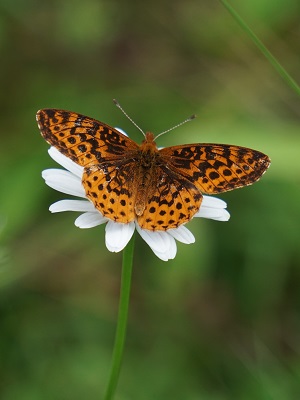Meadow fritillary (Boloria bellona)
With such striking coloration, this meadow fritillary (Boloria bellona) easily stands out against its floral backdrop when feeding and in flight. However, it needs to be a little more inconspicuous at times of rest. By situating itself on a dead plant and closing up its wings, this butterfly’s drab underwing (cryptic) coloration allows it to blend in with the dead flower buds. This camouflage, in addition to lack of movement, makes the meadow fritillary very difficult for predators to detect.
Meadow fritillary (Boloria bellona) with cryptic coloration
Meadow fritillaries belong to the family Nymphalidae, or brushfoots, for the long brush-like scales on their reduced forelegs, as seen below. The brushfoots use these modified appendages for chemoreception (taste and smell), leaving only four legs for walking. Other brushfoots include monarchs, admirals, commas, and pearl crescents, to name a few. Together they make up the largest family of butterflies with over 6,000 species worldwide. Like the meadow fritillary, many butterflies in the Nymphalidae family are brightly colored above with cryptic coloration below.
Meadow fritillary (Boloria bellona) with brush-like forelegs











